High Capacity Organic Radical Mediated Phosphorous Anode For Redox Flow Batteries
Delnick; Frank M. ; et al.
U.S. patent application number 16/519613 was filed with the patent office on 2020-01-23 for high capacity organic radical mediated phosphorous anode for redox flow batteries. The applicant listed for this patent is UT-BATTELLE, LLC. Invention is credited to Frank M. Delnick, Jagjit Nanda, Ethan C. Self.
| Application Number | 20200028197 16/519613 |
| Document ID | / |
| Family ID | 69162033 |
| Filed Date | 2020-01-23 |
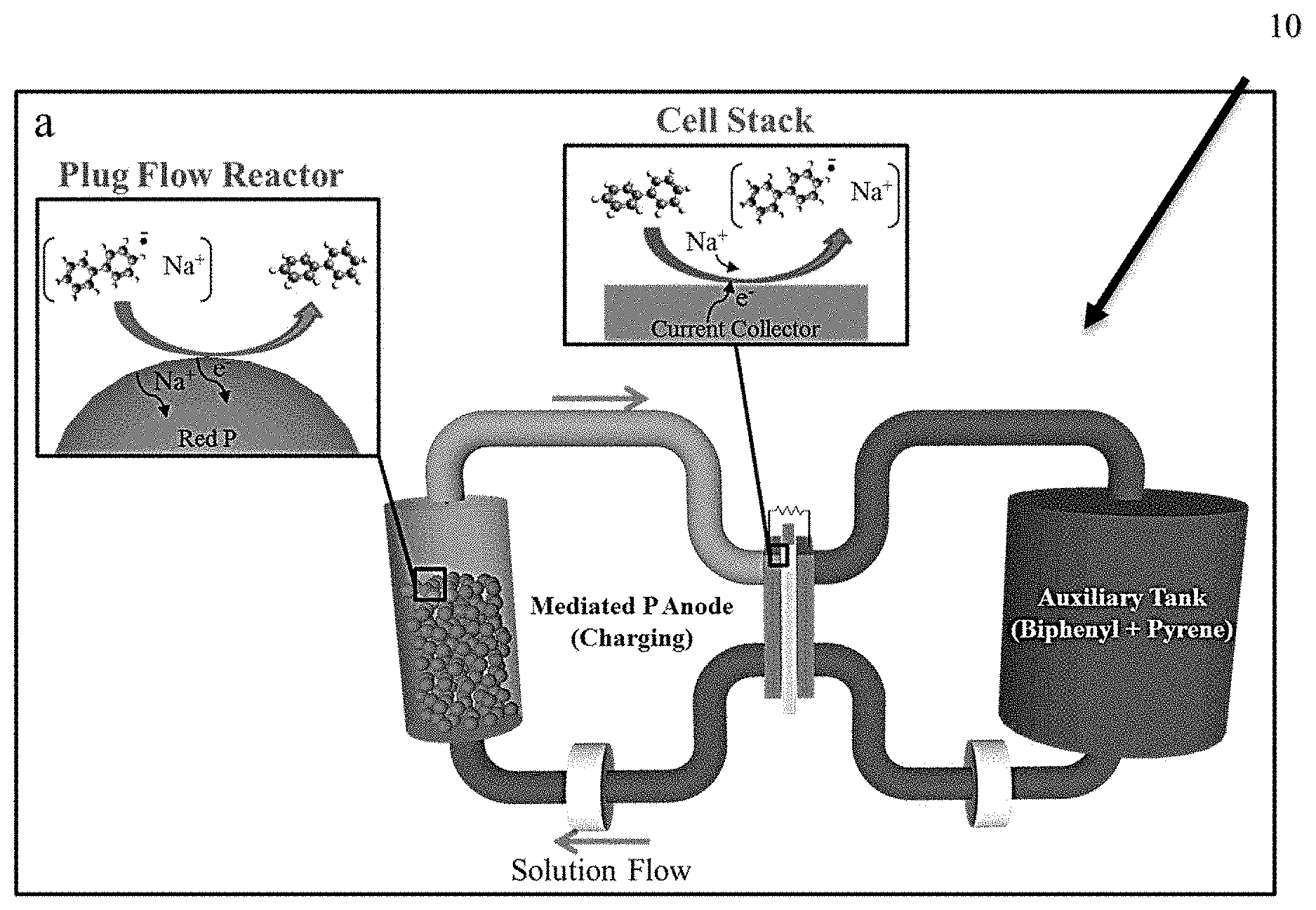
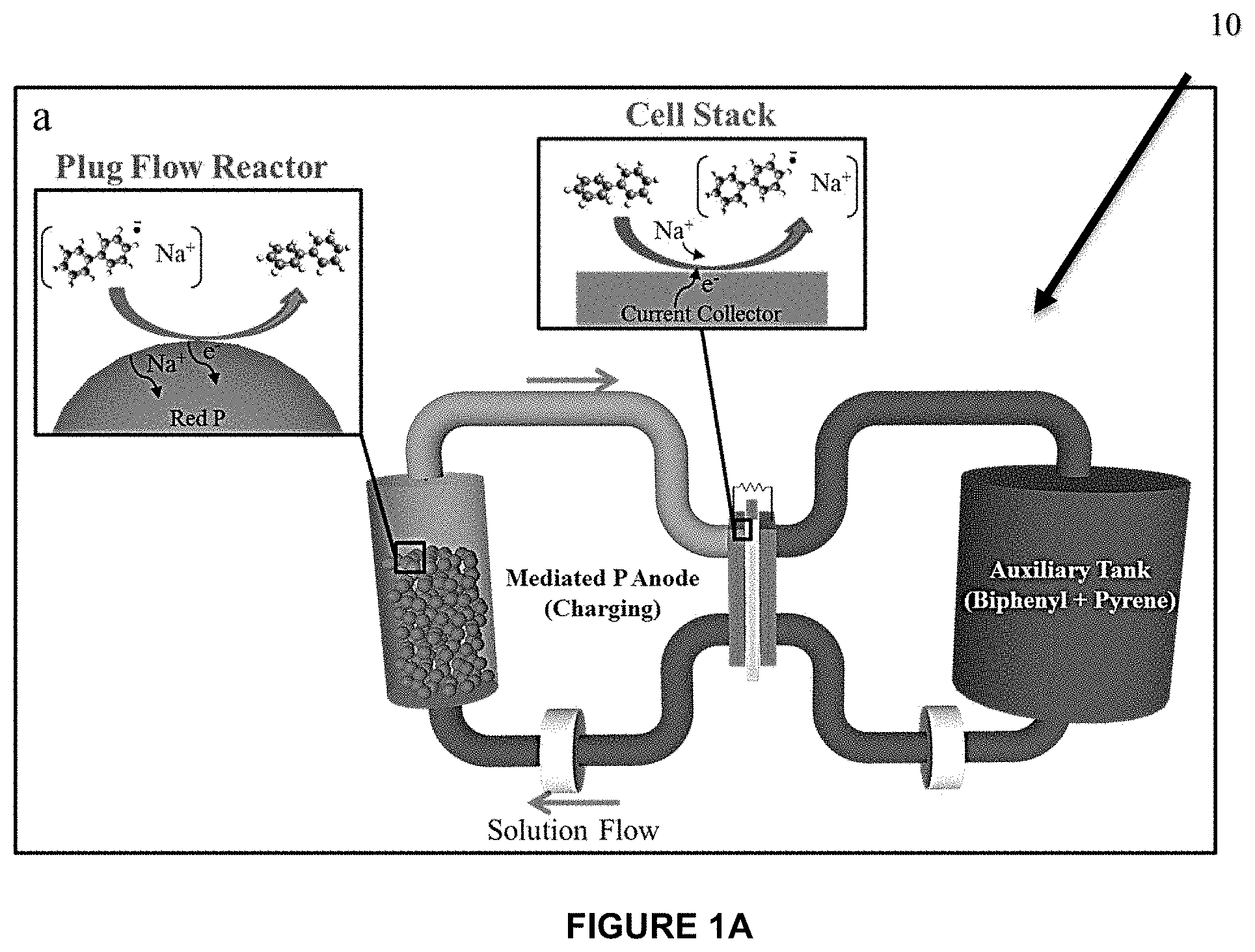
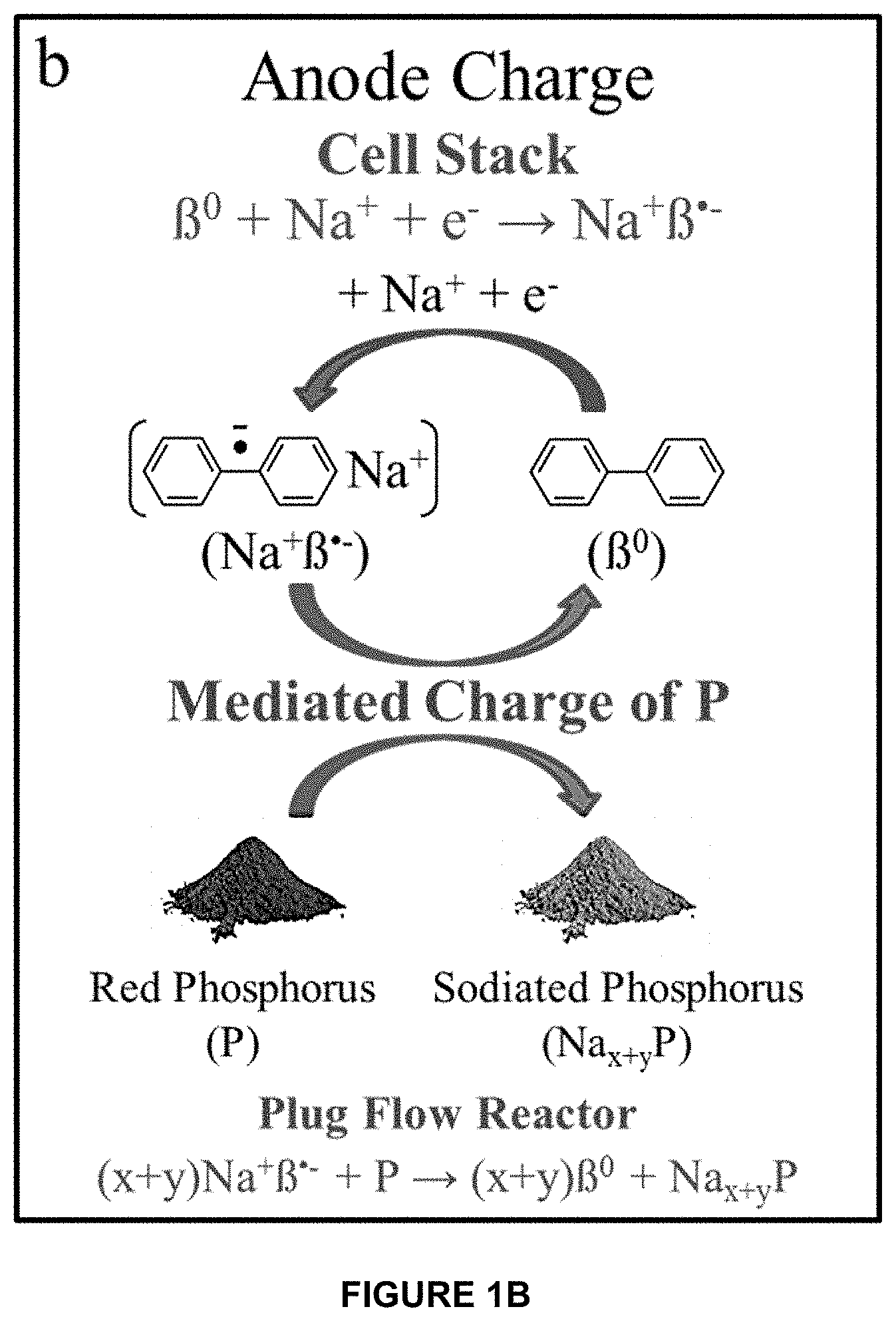
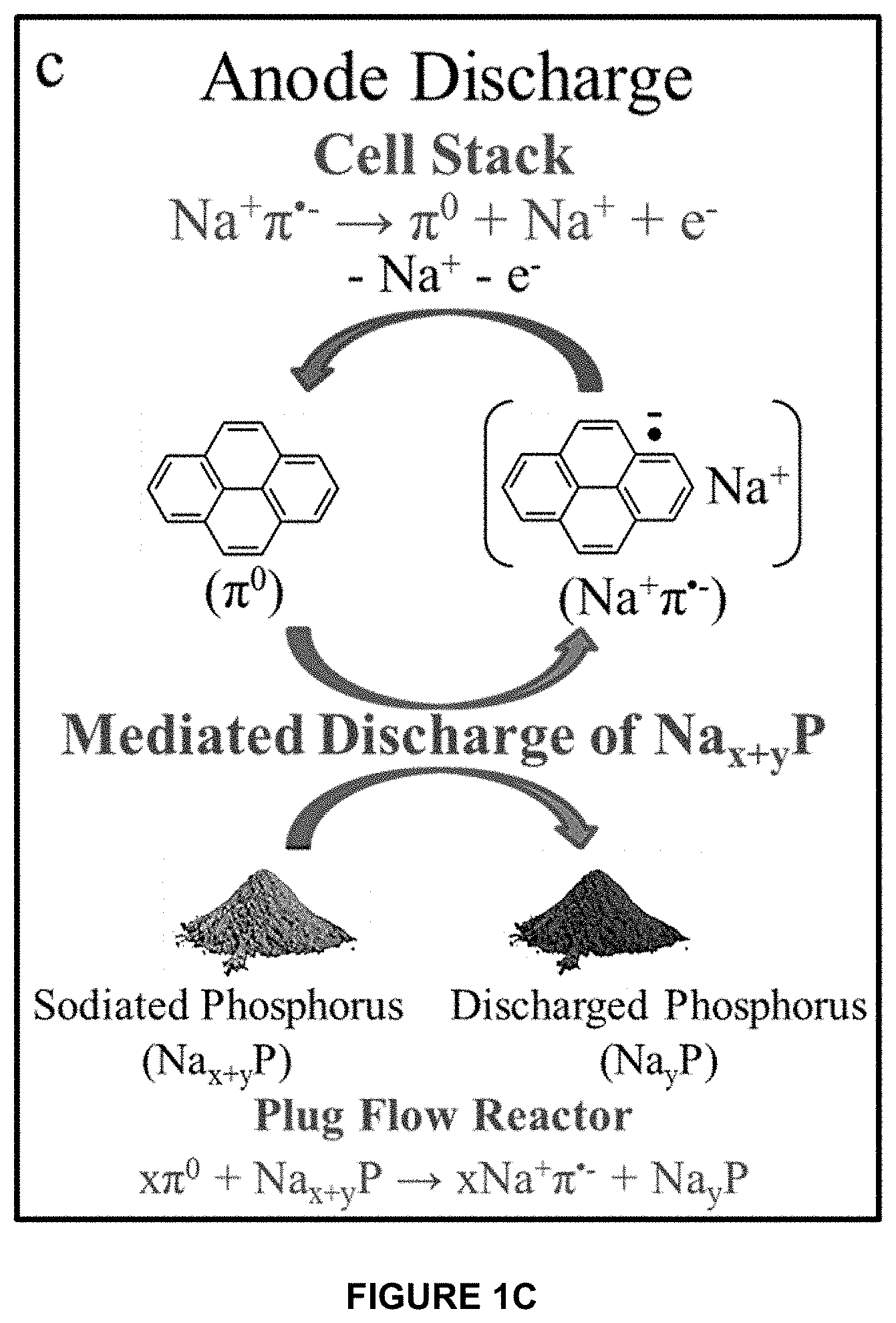
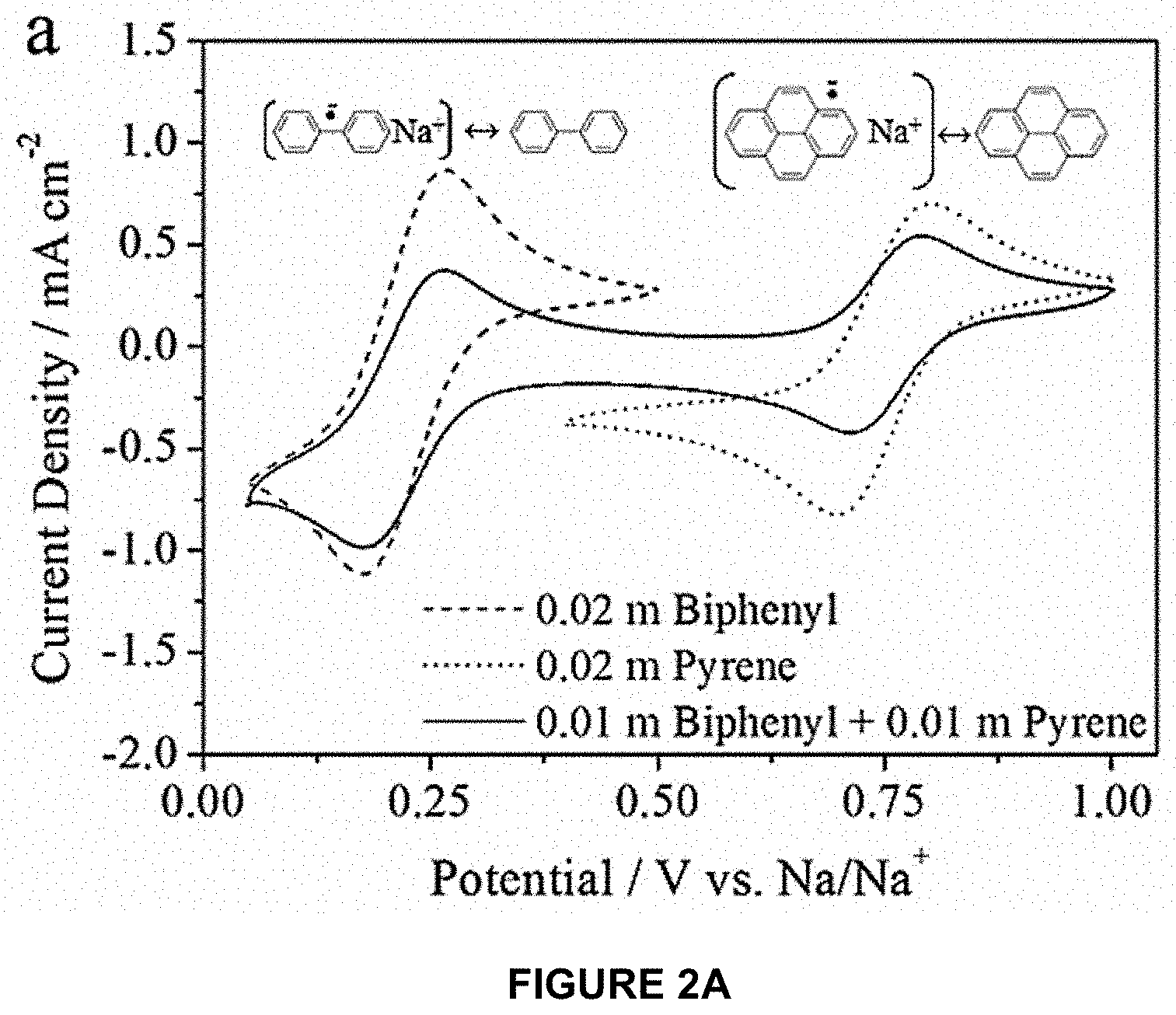
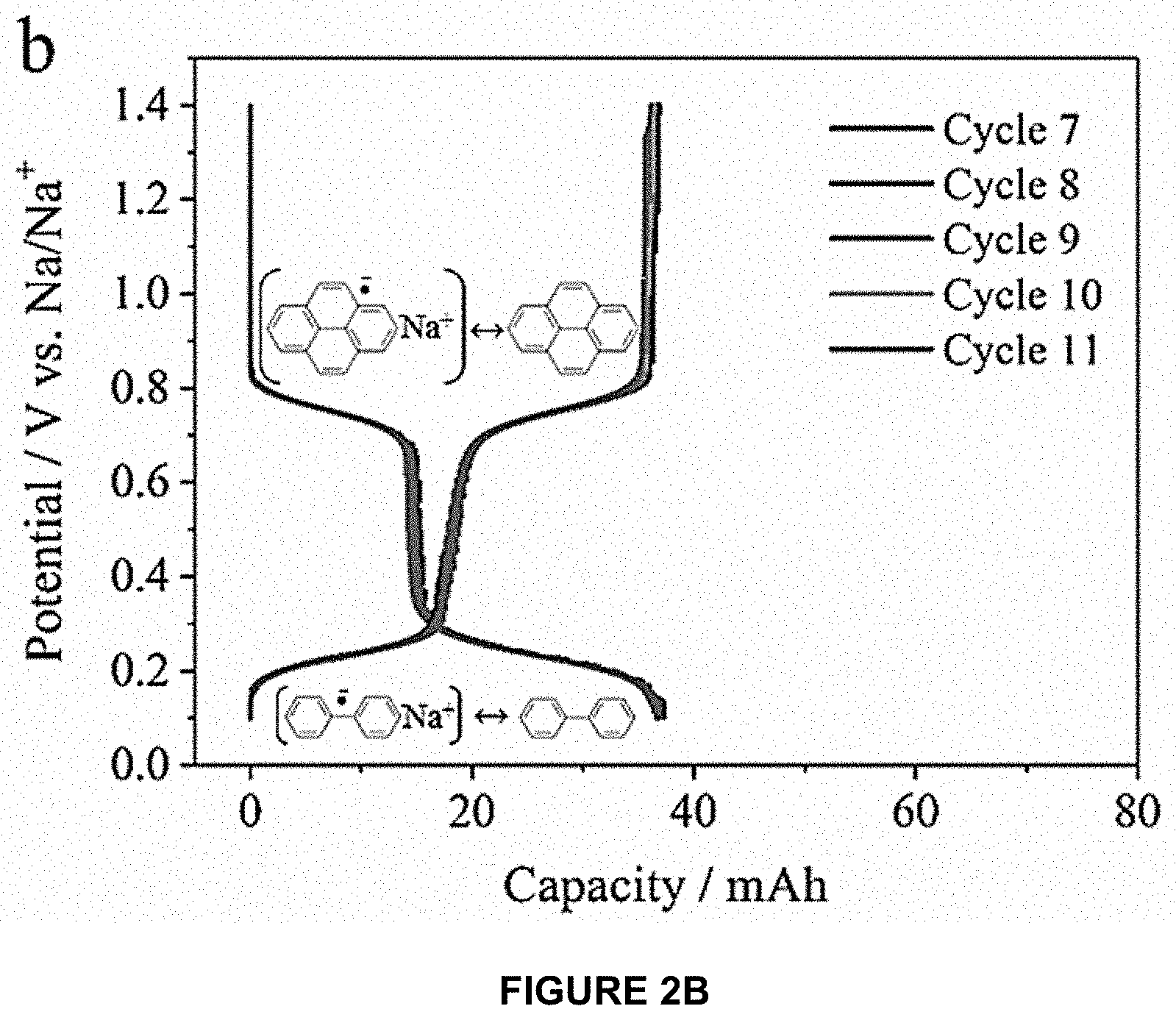

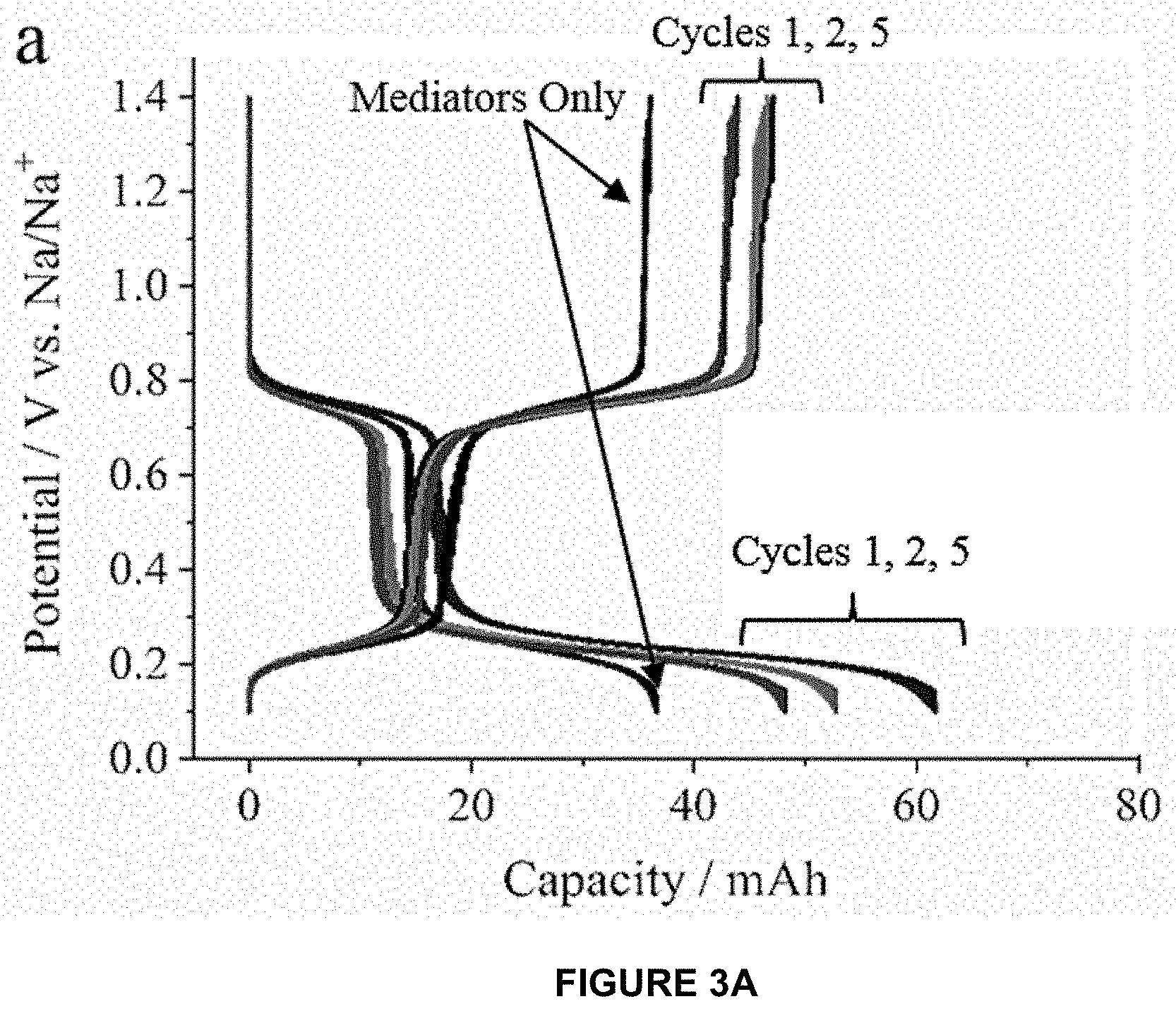




View All Diagrams
| United States Patent Application | 20200028197 |
| Kind Code | A1 |
| Delnick; Frank M. ; et al. | January 23, 2020 |
HIGH CAPACITY ORGANIC RADICAL MEDIATED PHOSPHOROUS ANODE FOR REDOX FLOW BATTERIES
Abstract
A battery includes a redox flow anode chamber coupled to an anode current collector, a separator, and an external container in fluid connection with the redox flow anode chamber. The external container has therein a solid phosphorus material. A first redox-active mediator and the second redox-active mediator are circulated through the half-cell electrode chamber and the external container. During a charging cycle the first redox-active mediator is reduced at the current collector electrode and the reduced first mediator reduces the phosphorus material, and wherein during a discharging cycle the second redox-active mediator is oxidized at the anode current collector electrode, and the second redox-active mediator is then reduced by the reduced phosphorus material. A method of operating a battery and a method of making a battery are also discussed.
| Inventors: | Delnick; Frank M.; (Maryville, TN) ; Nanda; Jagjit; (Knoxville, TN) ; Self; Ethan C.; (Oak Ridge, TN) | ||||||||||
| Applicant: |
|
||||||||||
|---|---|---|---|---|---|---|---|---|---|---|---|
| Family ID: | 69162033 | ||||||||||
| Appl. No.: | 16/519613 | ||||||||||
| Filed: | July 23, 2019 |
Related U.S. Patent Documents
| Application Number | Filing Date | Patent Number | ||
|---|---|---|---|---|
| 62701859 | Jul 23, 2018 | |||
| Current U.S. Class: | 1/1 |
| Current CPC Class: | H01M 8/188 20130101; H01M 8/0221 20130101; H01M 4/9041 20130101; H01M 4/8652 20130101 |
| International Class: | H01M 8/18 20060101 H01M008/18; H01M 4/86 20060101 H01M004/86; H01M 4/90 20060101 H01M004/90; H01M 8/0221 20060101 H01M008/0221 |
Goverment Interests
STATEMENT REGARDING FEDERALLY SPONSORED RESEARCH AND DEVELOPMENT
[0002] This invention was made with government support under Contract No. DE-AC05-00OR22725 awarded by the U.S. Department of Energy. The government has certain rights in this invention.
Claims
1. A battery, comprising: a redox flow anode chamber coupled to an anode current collector electrode; a separator conducting at least one selected from the group consisting of lithium ions and sodium ions, and coupled to the anode chamber, wherein the anode chamber comprises a first redox-active mediator and a second redox-active mediator; an external container in fluid connection with the redox flow anode chamber, the external container having therein a solid phosphorus material, wherein the first redox-active mediator and the second redox-active mediator are circulated through the half-cell electrode chamber and the external container; wherein the phosphorus material has an average redox potential between the redox potential of the first mediator and the redox potential of the second mediator, wherein during a charging cycle the first redox-active mediator is reduced at the current collector and subsequently reduces the phosphorus material, and wherein during a discharging cycle the second mediator is oxidized at the current collector, and the second redox-active mediator is then reduced by the reduced phosphorus material.
2. The battery of claim 1, wherein the first redox-active mediator is an arene comprising at least one selected from the group consisting of a polyaromatic hydrocarbon, biphenyl, or a substituted derivative of either thereof.
3. The battery of claim 2, wherein the second redox-active mediator comprises a second arene, wherein the second arene is a polyaromatic hydrocarbon, biphenyl, or a substituted derivative of either thereof, with the proviso that the second redox-active mediator is not the same as the first redox-active mediator.
4. The battery of claim 3, wherein the first or second arene is biphenyl or a substituted derivative thereof.
5. The battery of claim 1, wherein the first, second, or first and second redox-active mediator is an arene that is substituted, and includes one or more substituent groups, R, wherein each R is independently selected from a linear, branched, cyclic, or aromatic alkyl group having 1-50 carbon atoms, optionally functionalized with a functional group including O, S, or N.
6. The battery of claim 5, wherein the second arene is selected from the group consisting of: biphenyl, methylnaphthalene, naphthalene, acenaphthalyne, pyrene, anthracene, coronene, perylene, tetracene, fluorene, azulene, and chrysene, and substituted derivatives of any thereof, with the proviso that the second arene is not the same as the first arene.
7. The battery of claim 5, wherein the second redox-active mediator comprises a second arene, wherein the second arene is substituted or unsubstituted, with the proviso that the second arene is not the same as the first arene.
8. The battery of claim 1, wherein the active electrode in the external container is in a flow reactor configuration.
9. The battery of claim 1, wherein the battery comprises a cathode, and the cathode comprises a cathode half-cell electrode chamber coupled to a current collector electrode comprising an active cathode material.
10. The battery of claim 1, wherein the first redox-active mediator and the second redox-active mediator are dissolved in a non-aqueous solvent.
11. The battery of claim 10, wherein the solvent is at least one selected from the group consisting of: tetrahydro-furan, dimethoxyethane, diglyme, triglyme, tetraethyleneglycol dimethylether, and mixtures thereof.
12. The battery of claim 10, wherein the concentration of the first redox-active mediator in the solvent is from 0.1 to 2 Molar.
13. The battery of claim 10, wherein the concentration of the second redox-active mediator in the solvent is from 0.1 to 2 Molar.
14. The battery of claim 1, wherein the first redox-active mediator is biphenyl and the second redox-active mediator is pyrene.
15. A method of operating a battery, comprising the steps of: providing a redox flow anode chamber coupled to an anode current collector; providing a separator conducting at least one selected from the group consisting of Li+ and Na+, and coupled to the anode chamber, wherein the chamber comprises a first redox-active mediator and a second redox-active mediator; circulating the first redox-active mediator and the second redox-active mediator through the anode half-cell electrode chamber into an external container, wherein the external container contains therein a solid phosphorus material, wherein the phosphorus material has an average redox potential between the redox potential of the first mediator and the redox potential of the second mediator; during a charging cycle, reducing the first redox-active mediator at the current collector electrode and using the reduced first redox-active mediator to reduce the phosphorus material in the external container; during a discharge cycle, oxidizing the reduced second mediator at the current collector anode, and then reducing the second redox-active mediator with the reduced phosphorus material in the external container.
16. The method of claim 15, wherein the capacity of the mediated reaction is from 100 to 1900 mAH/g.
17. A method of making a battery, comprising the steps of: coupling a redox flow anode chamber to an anode current collector; coupling to the anode half-cell electrode chamber a separator conducting at least one selected from the group consisting of Li+ and Na+; coupling to the anode chamber an external chamber comprising a solid phosphorus material; placing into the redox flow half-cell electrode chamber a solvent containing a first redox-active mediator and a second redox active mediator, wherein the phosphorus material has an average redox potential between the redox potential of the first mediator and the redox potential of the second mediator, and the first redox-active mediator and the second redox-active mediator are selected for a redox voltage spread and operating voltage of the anode half-cell electrode chamber; coupling a cathode to the redox flow anode current collector electrode and to the separator.
Description
CROSS-REFERENCE TO RELATED APPLICATIONS
[0001] This application claims priority to U.S. Provisional application No. 62/701,859 filed on Jul. 23, 2018, entitled "PROCESS FOR ENERGY STORAGE IN A MEDIATED REDOX FLOW CELL", the entire disclosure of which incorporated herein by reference.
FIELD OF THE INVENTION
[0003] The present invention is related to flow batteries, and more particularly to mediated flow batteries.
BACKGROUND OF THE INVENTION
[0004] A battery's energy density is proportional to its capacity and operating voltage. Therefore, high energy batteries utilize high capacity anode materials which are oxidized and reduced at very negative potentials. Today's high energy batteries contain anodes comprised of either alkali metals, alkali metal alloys or lithium intercalation compounds, such as carbons and metal oxides. Of these materials, the alkali metals and alkali metal alloys exhibit the highest capacities, however, they also experience large volume change (>300%) during charge/discharge. These volume changes create: (i) discontinuities in the anode, such as pulverization of the active material, which limits cycle life, and (ii) and safety concerns when pressure is exerted across the cell separator. Furthermore, high energy anodes typically operate outside of the thermodynamic window of their respective electrolytes and only function through the formation of an ionically conductive passive film. Although essential for battery operation, these passive films limit charge/discharge rates and contribute to irreversible capacity losses in the cells which ultimately limits cycle life. These irreversible losses are further accelerated on anodes which experience large volume changes during battery operation. Therefore, a new process is needed to effectively utilize these high capacity anode materials.
[0005] The fundamental charge storage mechanisms in a number of currently studied high energy redox couples are based on intercalation, conversion, or displacement reactions, With exception to certain metal-air chemistries, most often the active redox materials are stored physically in the electrochemical cell stack thereby lowering the practical gravimetric and volumetric energy density as a tradeoff to achieve reasonable power density.
[0006] To enable the widespread adoption of renewable energy technologies, an electrical grid capable of storing intermittent energy sources such as solar and wind, must be developed. Redox flow batteries (RFBs) are promising energy storage devices for grid-level applications due to their extraordinarily long cycle life, resulting from the use of highly reversible redox couples, and the ability to independently scale their energy and power densities. A redox flow battery is a kind of battery where at least on one of the cathode and anode sides of the battery chemical energy is provided by a chemical component dissolved in a liquid and separated from the other electrode side by an ion exchange membrane. Ion exchange occurs across the membrane when the liquid circulates.
[0007] The energy density of a conventional RFB is dictated by its capacity, which is directly related to the solubility of the redox species in the electrolyte, and operating potential. Numerous RFB chemistries utilizing both aqueous and non-aqueous electrolytes have been explored. In general, aqueous systems have low operating potentials, such as 1.5 V, resulting in poor energy densities, for example 25-30 Wh/kg for an all-vanadium RFB. In comparison, the use of organic electrolytes with wider electrochemical windows moderately increases the energy density, but these devices are still ultimately limited by the solubility of the redox species in the electrolyte. To circumvent the solubility issue at the anode, some have investigated the use of Li metal anodes in a flow battery configuration. Despite their high energy densities, Li metal anodes present safety concerns due to dendrite formation and irreversible capacity losses caused by anode passivation. A promising yet largely unexplored approach for flow batteries utilizes electrochemically mediated reaction(s) to charge and/or discharge an active material.
[0008] There is shown in Table 1 performance data for mediated redox flow battery systems reported in the scientific literature.
TABLE-US-00001 TABLE 1 Performance summary of mediated redox flow batteries. Solid Material Solid Mediator Cycled Material Coulombic Current Concentration Capacity Utilization Cycle Efficiency Density Cell (mM) (mAh g.sup.-1) (%) No. (%) (.mu.A cm.sup.-2) Non-Aqueous Systems TiO.sub.2/LiFePO.sub.4 5 58 36 47 90 50-87 Li/LiFePO.sub.4 20 112 70 2 97 310 Li/LiFePO.sub.4 25 117 73 45 98 125-500 Li/TiO.sub.2 5 55 33 50 90-95 25 Li/TiO.sub.2 5 110 66 1 90 100 Li/Fe.sub.4[Fe(CN).sub.6].sub.3 15 53 42 30 90 50 Li/S 10 134 8 100 99.5 320 Li/O.sub.2 10 N/A N/A 35 -- 100 Li/LiFePO.sub.4 500 152 95 5 90 25 Li/LiFePO.sub.4 10 60 38 40 >99 25 Aqueous Systems LiTi.sub.2(PO.sub.4).sub.3/LiFePO.sub.4 300 128 80 55 99 500 poly(aniline)/carbon -- 46 32 25 97 38,500 half cell
[0009] Only two of these are full redox flow cells (TiO.sub.2/LiFePO.sub.4 and LiTi.sub.2(PO.sub.4).sub.3/LiFePO.sub.4). The remainder are mediated (redox target) battery reactions conducted in half-cell configuration, typically with lithium counter electrodes (hybrid redox flow configuration). Mediated redox flow battery technology is in the early stages of development, and most of the technology is far from optimized.
[0010] Other types of redox flow systems are being investigated. Some of these are summarized in Table 2 below:
TABLE-US-00002 TABLE 2 Redox Flow Solvent/ Estimated Systems Electrolyte Energy Density Limitations Vanadium Aqueous/acid, 25-30 Wh/Kg Low energy based proton density, high acid conducting concentration, membranes toxic Quinone- Aqueous, proton ~30-35 Wh/Kg Low energy HBr/Br.sub.2 conducting density, toxic membranes Slurry Non-aqueous ~100 Wh/Kg Rheology control, based flow low power density, cost Lithium-metal/ Mixed ~150 Wh/Kg Lithium metal aqueous redox solvents/Solid passivation, flow cathode electrolyte dendrites, safety separator issues Lithium Non-aqueous ~200 Wh/Kg Lithium metal metal/organic passivation, cathode dendrites, safety issues, requires new membrane
[0011] In one general embodiment, a mediated redox flow battery can include a series of secondary organic molecules that form highly reduced anion radicals as reaction mediator pairs for the reduction and oxidation of primary high capacity redox species ex situ from the electrochemical cell stack. Arenes are reduced to stable anion radicals that in turn reduce a primary anode to the charged state. The primary anode is then discharged using a second arene which operates at a more positive potential. There is shown in U.S. Pat. No. 9,859,583 (Jan. 2, 2018) "Polyarene Mediators for Mediated Redox Flow Battery" a type of redox flow battery with examples of such organic mediators. The disclosure of this reference is hereby incorporated fully by reference. There is a continuing need for redox flow battery systems which have high capacity and cycle life.
SUMMARY OF THE INVENTION
[0012] A battery according to the invention can include a redox flow anode chamber coupled to an anode current collector electrode. A separator conducts one selected from the group consisting of lithium ions and sodium ions, and is coupled to the anode chamber. The anode chamber includes a first redox-active mediator and a second redox-active mediator.
[0013] An external container is in fluid connection with the redox flow anode chamber. The external container has therein a solid phosphorus material. The first redox-active mediator and the second redox-active mediator are circulated through the half-cell electrode chamber and the external container.
[0014] The phosphorus material has an average redox potential between the redox potential of the first mediator and the redox potential of the second mediator. During a charging cycle the first redox-active mediator is reduced at the current collector and subsequently reduces the phosphorus material. During a discharging cycle the second mediator is oxidized at the current collector, and the second redox-active mediator is then reduced by the reduced phosphorus material.
[0015] A method of operating a battery includes the step of providing a redox flow anode chamber coupled to an anode current collector, and providing a separator conducting one selected from the group consisting of Li+ and Na+, and coupled to the anode chamber, wherein the chamber comprises a first redox-active mediator and a second redox-active mediator.
[0016] The first redox-active mediator and the second redox-active mediator are circulated through the anode half-cell electrode chamber into an external container, wherein the external container contains therein a solid phosphorus material, wherein the phosphorus material has an average redox potential between the redox potential of the first mediator and the redox potential of the second mediator. During a charging cycle, the first redox-active mediator is reduced at the current collector electrode and the reduced first redox-active mediator is used to reduce the phosphorus material in the external container. During a discharge cycle, the reduced second mediator is oxidized at the current collector anode, and then the second redox-active mediator is reduced with the reduced phosphorus material in the external container.
[0017] A method of making a battery includes the steps of coupling a redox flow anode chamber to an anode current collector, coupling to the anode half-cell electrode chamber a separator conducting at least one selected from the group consisting of Li+ and Na+, and coupling to the anode chamber an external chamber comprising a solid phosphorus material. A solvent is placed into the redox flow half-cell electrode chamber. The solvent contains a first redox-active mediator and a second redox active mediator, wherein the phosphorus material has an average redox potential between the redox potential of the first mediator and the redox potential of the second mediator, and the first redox-active mediator and the second redox-active mediator are selected for a redox voltage spread and operating voltage of the anode half-cell electrode chamber. A cathode is coupled to the redox flow anode current collector electrode and to the separator.
BRIEF DESCRIPTION OF THE DRAWINGS
[0018] There are shown in the drawings embodiments that are presently preferred it being understood that the invention is not limited to the arrangements and instrumentalities shown, wherein:
[0019] FIG. 1A is a schematic diagram of a redox flow battery according to the invention; FIG. 1B is a schematic depiction of a mediated charge reaction for phosphorus in the flow reactor; FIG. 1C is a schematic depiction of a mediated discharge reaction of Na.sub.x+y P in a redox flow reactor.
[0020] FIG. 2A shows cyclic voltammograms of electrolytes containing biphenyl and/or pyrene with 0.9 m and NaTFS in diglyme collected at a scan rate of 10 mV/s; FIG. 2B shows charge/discharge curves of a redox flow cell containing biphenyl and pyrene mediators; FIG. 2C shows the cycling performance of this cell wherein open/closed symbols represent reduction/oxidation capacities, respectively.
[0021] FIG. 3A shows charge/discharge curves of a flow cell containing biphenyl, pyrene, and red phosphorus powder; FIG. 3B shows the first cycle voltage profile and illustrates how mediated charge/discharge capacities were calculated; and FIG. 3C shows mediated reduction/oxidation capacities of red phosphorus over 9 cycles. Experiments were conducted at a current of 5 mA, corresponding to a current density of 0.78 mA/cm.sup.2 (calculated based on the membrane's active surface area).
[0022] FIG. 4 shows representative charge/discharge curves collected at currents of 1 and 5 mA, corresponding to 0.16 and 0.78 mA/cm.sup.2, respectively, for a redox flow cell containing biphenyl and pyrene mediators with red phosphorus powder.
[0023] FIG. 5 summarizes the capacity and coulombic efficiency for the RFB experiments with and without red phosphorus. Experiments were conducted at a current of 5 mA, corresponding to 0.78 mA/cm.sup.2. Electrolyte compositions of the working and auxiliary compartments are given in Table 3.
DETAILED DESCRIPTION OF THE INVENTION
[0024] A battery includes a redox flow anode half-cell electrode chamber coupled to an anode current collector. A separator conducts one selected from the group consisting of lithium ions and sodium ions, and is coupled to the anode chamber. The anode chamber includes two soluble redox-active mediators. An external container is in fluid connection with the redox flow anode chamber. The external container has therein a solid phosphorus (P) material. The first redox-active mediator and the second redox-active mediator are circulated through the anode chamber and the external container.
[0025] The phosphorus material has an average redox potential between the redox potential of the first redox-active mediator and the redox potential of the second redox-active mediator. During a charging cycle, the first redox-active mediator is reduced at the anode current collector, and the reduced first mediator subsequently reduces the phosphorus material. During a discharging cycle, the second redox-active mediator is oxidized at the anode current collector, and the second redox-active mediator is then reduced by the reduced phosphorus material.
[0026] The phosphorus can be provided in different forms. The phosphorus can be provided as powders or pellets. The phosphorus can be secured to a porous support, such as a mesh, which allows liquid to flow there through while permitting good contact between the phosphorus and the mediators.
[0027] The first redox-active mediator can be an arene comprising at least one selected from the group consisting of a polyaromatic hydrocarbon, biphenyl, or a substituted derivative of either thereof. Other first redox-active mediators are possible.
[0028] The second redox-active mediator can be a second arene. The second arene can be a polyaromatic hydrocarbon, biphenyl, or a substituted derivative of either thereof, with the proviso that the second redox-active mediator is not the same as the first redox-active mediator. Other second redox-active mediators are possible.
[0029] The first or second arene can be biphenyl or a substituted derivative thereof. The first, second, or first and second redox-active mediator can be an arene that is substituted, and includes one or more substituent groups, R, wherein each R is independently selected from a linear, branched, cyclic, or aromatic alkyl group having 1-50 carbon atoms, optionally functionalized with a functional group including O, S, or N. The second arene can be at least one selected from the group consisting of: biphenyl, methylnaphthalene, naphthalene, acenaphthalyne, pyrene, anthracene, coronene, perylene, tetracene, fluorene, azulene, and chrysene, and substituted derivatives of any thereof, with the proviso that the second arene is not the same as the first arene. The first redox-active mediator can be biphenyl and the second redox-active mediator can be pyrene (sometimes hereafter denoted as ".mu." and ".pi.", respectively).
[0030] The external container can have different configurations. In one embodiment, the external container can have a flow reactor configuration, with a liquid inlet and outlet. Liquid electrolyte including the first and second mediators flows from the anode chamber to the liquid inlet, and flows through the external container to contact the phosphorus. Liquid flows from the liquid outlet back to the anode chamber.
[0031] A cathode is provided and can be any suitable cathode. In one embodiment, the cathode can include a cathode chamber coupled to a current collector comprising an active cathode material. Other cathode designs are possible.
[0032] The first redox-active mediator and the second redox-active mediator can be dissolved in a non-aqueous solvent. Many different solvents are possible. The solvent can be at least one selected from the group consisting of: tetrahydrofuran, dimethoxyethane, diglyme, triglyme, tetraethyleneglycol dimethylether, and mixtures thereof.
[0033] The concentration of the first redox-active mediator and the second redox-active mediator can vary. The concentration of the first redox-active mediator in the solvent is from 0.1 to 2 molar. The concentration of the second redox-active mediator in the solvent can vary from 0.1 to 2 molar. The concentration of either the first or second redox-active mediator can be 0.1, 0.2, 0.3, 0.4, 0.5, 0.6, 0.7, 0.8, 0.9, 1.0, 1.1, 1.2, 1.3, 1.4, 1.5, 1.6, 1.7, 1.8, 1.9, or 2.0, or can with within a range of any high value and low value selected from these values.
[0034] A method of operating a battery can include the step of providing a redox flow anode chamber coupled to a current collector. A separator conducting at least one selected from the group consisting of Li.sup.+ and Na.sup.+ is positioned between the anode and a cathode, and coupled to the anode chamber. The anode chamber contains a first redox-active mediator and a second redox-active mediator.
[0035] The first redox-active mediator and the second redox-active mediator are circulated through the anode chamber into an external container having a solid phosphorus material therein. The phosphorus material has an average redox potential between the redox potential of the first redox-active mediator and the redox potential of the second redox-active mediator.
[0036] During a charging cycle, the first redox-active mediator is reduced at the current collector, and the reduced first redox-active mediator is used to reduce the phosphorus material in the external container. During a discharge cycle, the reduced second mediator is oxidized at the current collector anode and then reduced by the reduced phosphorus material in the external container.
[0037] The capacity of the mediated reaction can be from 100 to 1900 mAH/g. The capacity of the mediated reaction can be 100, 150, 200, 250, 300, 350, 400, 450, 500, 550, 600, 50, 700, 750, 800, 850, 900, 90, 1000, 1050, 1100, 1150, 1200, 1250, 1300, 1350, 1400, 1450, 1500, 1550, 1600, 1650, 1700, 1750, 1800, 1850, and 1900 mAHr/g, or within a range of any high value and low value selected from these values.
[0038] A battery according to the invention can be made by any suitable process. In one embodiment, the battery can be made by coupling a redox flow anode chamber to an anode current collector. A separator conducting at least one selected from the group consisting of Li.sup.+ and Na.sup.+ is coupled to the anode chamber. An external chamber comprising a solid phosphorus material is coupled to the anode chamber. A solvent containing a first redox-active mediator and a second redox active mediator is placed into the redox flow chamber. The phosphorus material has an average redox potential between the redox potential of the first mediator and the redox potential of the second mediator. The first redox-active mediator and the second redox-active mediator can be selected for a desired redox voltage spread and operating voltage of the anode chamber. A cathode is coupled to the redox flow anode and to the separator.
[0039] The invention uses mediated electrochemical reactions such as with arene anion radical redox species (biphenyl and pyrene, denoted as 13 and .pi., respectively) to utilize a high capacity P anode in a redox flow configuration. A battery 10 according to the invention is illustrated schematically in FIG. 1A. The anion radicals are transferred to a flow reactor containing red P powder which is sodiated/desodiated through mediated electrochemical reactions. During charge, a biphenyl anion radical pair (Na+ .-) reduces red P powder to Na.sub.x+yP, producing the neutral biphenyl species ( .sub.0) which is recycled back to the cell stack where the anion radical pair is regenerated. This process continues until the P powder is fully sodiated. To discharge the Na.sub.x+yP powder, a second arene (pyrene, .pi.) is included in the anode electrolyte. Pyrene oxidizes the Na.sub.x+yP to Na.sub.yP (0<y<3), yielding the solvated ion pair Na.sup.+.pi...sup.- which is subsequently oxidized to the parent pyrene (.pi..sub.0) in the cell stack. The overall charge and discharge reactions are illustrated in FIGS. 1B and 1C, respectively.
[0040] FIG. 1A is a schematic illustration showing reversible Na storage in a red P anode using biphenyl and pyrene mediators (denoted and .pi., respectively). The mediated charge/discharge reactions occur in a plug flow reactor containing red P powder, and the mediator species are electrochemically regenerated in the cell stack. In the present half-cell study, the auxiliary tank contained soluble redox species (biphenyl and pyrene) for charge compensation. FIG. 1B is a schematic depiction of a mediated charge reaction for phosphorus in the flow reactor. FIG. 1C is a schematic depiction of a mediated discharge reaction of Na.sub.x+yP in a redox flow reactor.
[0041] Mediated RFBs according to the invention offer several major advantages over other RFB technologies. Because the anion radical species can be recycled several times through the cell stack during a single charge/discharge cycle, a mediated RFB's energy density is decoupled from the redox species' solubility in the electrolyte. Furthermore, the anode's performance is unaffected by volumetric changes of P since the mediated reactions occur in the flow reactor and do not require P to be electronically wired into the cell stack. Finally, the flow reactor ensures inherently safe battery operation since an accidental short circuit through the membrane will not result in a dangerous thermal runaway scenario.
[0042] The mediated red P anode can be a Na.sup.+-based mediated RFB anode which operates at a very negative potential, for example .about.1.3 V more negative than TiO.sub.2. The invention provides a high capacity mediated reaction, 800 mAHr/g, which is 5.times. to 10.times. higher than other reported capacities for mediated RFB systems. The invention is a conversion reaction anode with high volume expansion/contraction (.about.300 vol %). The non-aqueous cells utilized mediator concentrations 3 to 25.times. higher than other non-aqueous cells. The cell can be cycled at 2-30.times. higher current densities compared to other nonaqueous cells.
[0043] The charge and discharge of the anode material is mediated in a redox-flow battery configuration by using a thermodynamically stable non-passivating electrolyte which is separated from the cathode using a selective cation conducting membrane. The arene mediator with the most negative standard reduction potential is the biphenyl anion radical, Eo.about.0.2 V vs. Na/Na+), but this radical cannot reduce the alkali metal cations (upon charge), and it can reduce only a small fraction of the theoretical capacity of the alkali metal alloys. The invention provides a high energy anode which is enabled by the mediated charge and discharge of phosphorus (active anode material) in a redox flow configuration. The appropriate selection of mediators, electrolyte, and membrane enables the charge and discharge of the phosphorus anode material at very negative potentials and very high active material utilization. Inert conductive additives, and binders are not required. The phosphorus is not formed into a conventional electrode.
[0044] Phosphorus can be charged to form sodium phosphide (Na.sub.3P) with a theoretical capacity of 2,596 mAh/g.sub.P at potentials <.about.1 V vs. Na/Na.sup.+. Na and P are inexpensive and abundant resources which make them ideal candidates for large-scale electrochemical energy storage devices. Despite these attractive properties, the performance of P anodes has been hindered by the large volume changes of P (308% expansion when forming Na.sub.3P) during battery operation. Conventional electrodes containing P, conductive additive, and binder exhibit poor cycling stability due to repeated swelling/shrinking of P which results in electronic isolation of the active material. The invention addresses this problem by the placement of the phosphorus in the external container.
[0045] Electrochemical Characterization of Organic Mediators
[0046] The fundamental redox properties of electrolytes containing biphenyl and/or pyrene dissolved with 0.9 m sodium trifluoromethanesulfonate (NaTFS) in diglyme were first investigated. FIG. 2 shows cyclic voltammograms of electrolytes containing biphenyl and/or pyrene with 0.9 m NaTFS in diglyme collected at a scan rate of 10 mV/s. As shown in FIG. 2A, the cyclic voltammograms of electrolytes containing either 0.02 m biphenyl or 0.02 m pyrene exhibited half-wave potentials (E.sub.1/2, determined from the average of the anodic and cathodic peak positions) of 0.22 and 0.75 V vs. Na/Na.sup.+, respectively. These results demonstrate that biphenyl and pyrene operate within an appropriate potential range to drive reversible Na storage in a red P anode, wherein most of the capacity is available ca. 0.1-1 V vs. Na/Na.sup.+).
[0047] An electrochemical cell was created to evaluate the redox properties of biphenyl and pyrene in a flow battery configuration. The electrolyte in the working compartment contained 22 mAh of biphenyl+22 mAh of pyrene (see Table 3) and was cycled between 0.1-1.4 V vs. Na/Na.sup.+ at a current of 5 mA (corresponding to 0.78 mA/cm.sup.2 and a C-rate of 0.125 C). Representative charge/discharge curves are shown in FIG. 2B. The two plateaus near 0.75 and 0.23 V vs. Na/Na.sup.+ during reduction correspond to formation of Na.sup.+.pi...sup.- and Na ..sup.- as given by Equations 1 and 2, respectively:
Pyrene Redox: .pi..sup.0+Na.sup.++e.sup.-.revreaction.Na.sup.+.pi...sup.- E.sub.1/2=0.75V vs. Na/Na.sup.+ (1)
Biphenyl Redox: .sup.0+Na.sup.++e.sup.-.revreaction.Na.sup.+ ..sup.- E.sub.1/2=0.22V vs. Na/Na.sup.+ (2)
[0048] During the oxidation steps, minimal voltage hysteresis (<10 mV) was observed for both plateaus, and each species exhibited very reproducible behavior over several cycles as shown in FIG. 2C. The reduction and oxidation capacities for each plateau differed by 3-4 mAh/cycle, but the overall irreversible capacity loss was only .about.0.5 mAh/cycle (corresponding to 98-99% coulombic efficiency). This irreversible capacity loss was most likely due to a side reaction involving pyrene.
[0049] Electrochemical Mediation of a Red Phosphorus Anode
[0050] To demonstrate the feasibility of the mediated RFB anode shown in FIG. 1A, red P powder (22 mg, corresponding to 57 mAh assuming formation of Na.sub.3P) was added to the electrolyte in the working electrode compartment after performing the measurements shown in FIG. 2C. A small quantity of P (i.e., a theoretical capacity ratio Q.sub.P/Q.sub. +.pi..about.1.5) was used to establish proof-of-concept, but practical devices would contain higher P loadings to achieve high energy density. The mediated charge and discharge reactions are summarized in Equations 3 and 4:
Mediated Charge:(x+y)Na.sup.+ ..sup.-+P.fwdarw.(x+y) .sup.0+Na.sub.x+yP (3)
Mediated Discharge: x.pi..sup.0+Na.sub.x+yP.fwdarw.xNa.sup.+.pi...sup.-+Na.sub.yP (4)
where 0.ltoreq.x+y.ltoreq.3 depending on the reaction conversion. FIGS. 3A-C demonstrate the electrochemical characterization of a flow cell containing biphenyl, pyrene, and red P powder. FIG. 3A shows charge/discharge curves. FIG. 3B shows 1.sup.st cycle voltage profile showing the calculation of mediated charge/discharge capacities. FIG. 3C shows mediated reduction/oxidation capacities of red P over 9 cycles. Experiments were conducted at a current of 5 mA (corresponding to 0.78 mA/cm.sup.2).
[0051] During galvanostatic reduction (see FIG. 3A), pyrene and biphenyl were converted from the neutral species (.pi..sup.0 and .sup.0) to the anion radical pairs (Na.sup.+.pi...sup.- and Na.sup.+ ..sup.-) at .about.0.75 and .about.0.23 V vs. Na/Na.sup.+, respectively. The Na.sup.+ ..sup.- subsequently reacted with red P powder to produce Na.sub.x+yP and .sup.0 (Equation 3). The neutral biphenyl was then circulated back to the cell stack to regenerate Na.sup.+ ..sup.- until the P was fully sodiated. The mediated sodiation capacity was 1,370 mAh/g.sub.P (corresponding to formation of Na.sub.1.58P) as calculated using the method shown in FIG. 3B. During the oxidation steps, Na.sup.+ ..sup.- and Na.sup.+.pi...sup.- were oxidized to their neutral forms. .pi..sup.0 subsequently desodiated the Na.sub.x+yP to Na.sub.yP (Equation 4), forming Na.sup.+.pi...sup.- which was recycled back to the cell stack to regenerate .pi..sup.0. The capacity measured .about.0.75 V vs. Na/Na.sup.+ during oxidation was much greater than that which can be attributed to the pyrene content (see FIG. 3A), demonstrating that the pyrene successfully mediated the desodiation reaction. FIG. 3C shows the initial desodiation capacity was 710 mAh/g.sub.P and gradually faded to 670 mAh/g.sub.P over 9 cycles. When the current density was reduced from 0.78 to 0.16 mA/cm.sup.2 (see FIG. 4, significantly higher sodiation and desodiation capacities were measured (1,900 and 1,120 mAh/g.sub.P corresponding to stoichiometries of Na.sub.2.20P and Na.sub.0.91P, respectively), indicating the system was limited by the reaction rate between the mediators and P powder. Despite issues with the pyrene mediator, the performance of the red P anode shown here compares well with previous reports on mediated and redox-targeted approaches for RFBs. Table 1 summarizes the performance of systems related to this topic. The invention uses an external flow reactor wherein reversible Na storage in a red P powder is mediated using soluble arene anion radicals (biphenyl and pyrene). Consequently, the energy density of the system increases with the P/mediator mass ratio. Since the mediated electrochemical reactions occur outside the cell stack, this method allows for efficient utilization of active materials which are difficult to incorporate into conventional electrodes due to large volume changes, low electronic conductivity, etc. The invention can be adapted to include either Na-based or Li-based anodes and cathodes by selecting appropriate mediators that bound the operating potential window of the active material. Ultimately, such mediated electrochemical reactions can be used to develop low-cost, high energy density RFBs.
[0052] Cyclic Voltammetry Experiments
[0053] A three electrode cell was used to collect cyclic voltammograms with electrolytes containing: (i) 0.02 m biphenyl (99.5%, Sigma-Aldrich), (ii) 0.02 m pyrene (98%, Sigma-Aldrich), and (iii) 0.01 m biphenyl+0.01 m pyrene with 0.9 m sodium trifluoromethanesulfonate (NaTFS, 98%, Sigma-Aldrich) dissolved in diglyme. Na metal (ACS reagent grade, Sigma-Aldrich) was added to the solutions such that the molar ratio of the anion radical/neutral species was 1/1. Cyclic voltammograms were collected using a Au working electrode (1.6 mm diameter, polished to 0.050 .mu.m), Ti counter electrode (6.4 mm diameter), and Na reference electrode. The reference electrode contained Na metal submerged in a solution of 1 m NaTFS in tetraglyme (99%, Sigma-Aldrich) and was separated from the cell's electrolyte by a poly(ethylene oxide)/NaTFS/tetraglyme membrane.
[0054] Voltammograms were acquired by polarizing the working electrode between 0.05-1.50 V vs. Na/Na.sup.+ at a scan rate of 10-100 mV/s using a Biologic SP-200 potentiostat. The solution resistance between the working and reference electrodes was estimated using a current interruption method in which a .about.5 .mu.A pulse current was applied for 0.05 s, and the potential response was measured. The calculated solution resistance (867.+-.55 0 for each electrolyte) during the cyclic voltammograms was automatically compensated in the EC-Lab software. At least 5 scans were conducted with each system to ensure collection of stable and reproducible voltammograms.
[0055] Redox Flow Cell Experiments
[0056] Flow cell experiments were conducted in an Ar-filled glovebox using a custom stainless steel electrochemical cell. Ni foam electrodes (2.54.times.2.54 cm.sup.2 footprint, 0.125-0.130 cm thick, MTI Corp) were spot welded over serpentine flow channels. A Na- '' Al.sub.2O.sub.3 membrane (4.5.times.4.5 cm.sup.2 footprint, 1.5 mm thick, Ionotec Ltd.) was placed between Celgard 2325 separator layers and butyl rubber gaskets, and the cell was torqued to 10 in-lbs. Syringe pumps were used to intermittently circulate electrolyte at 5 mL/min back-and-forth through each side of the cell via polypropylene Luer fittings and polypropylene tubing. Ultra-high purity Ar (passed through a ppb gas scrubber) flowed over the headspace of the solution reservoirs to avoid side reactions of the anion radical solutions with trace impurities (e.g., CO.sub.2) in the glovebox. The electrolyte added to the working and auxiliary electrode compartments (approximately 10 and 35 mL, respectively) contained NaTFS, biphenyl, and pyrene dissolved in diglyme. Species concentrations in the electrolyte are listed in Table 3. Red P powder (98.9%, 100 mesh, Alfa-Aesar) was added directly to the working compartment for the mediated RFB tests.
TABLE-US-00003 TABLE 3 Species concentration in the working and auxiliary compartments for the electrochemical cells evaluated in this study. Working Compartment Auxiliary Compartment Concen- Concen- Cell tration Theoretical tration Theoretical Config- (mol/ Capacity* (mol/ Capacity* uration Species kg.sub.diglyme) (mAh) kg.sub.diglyme) (mAh) Flow Cell NaTFS 0.728 N/A 0.372 N/A Biphenyl 0.0768 22.1 0.234 210 Pyrene 0.0768 22.1 0.235 211 *Theoretical capacities calculated assuming a 1 e.sup.- transfer
[0057] A Biologic SP-200 potentiostat was used to perform galvanostatic charge/discharge experiments in which the working electrode was cycled between 0.10-1.4 V vs. Na/Na.sup.+ at currents of 1 and 5 mA (corresponding to 0.16 and 0.78 mA/cm.sup.2, respectively, based on the active surface area of the Na- '' Al.sub.2O.sub.3 membrane). A Na reference electrode (Na metal submerged in a 1m NaTFS/tetraglyme solution separated by a polyethylene oxide/NaTFS/tetraglyme membrane) was used to monitor the potential of the working electrode.
[0058] The invention as shown in the drawings and described in detail herein disclose arrangements of elements of particular construction and configuration for illustrating preferred embodiments of structure and method of operation of the present invention. It is to be understood however, that elements of different construction and configuration and other arrangements thereof, and methods of operation other than those illustrated and described may be employed in accordance with the spirit of the invention, and such changes, alterations and modifications as would occur to those skilled in the art are considered to be within the scope of this invention as broadly defined in the appended claims. In addition, it is to be understood that the phraseology and terminology employed herein are for the purpose of description and should not be regarded as limiting.
* * * * *
D00000

D00001

D00002

D00003

D00004

D00005

D00006

D00007

D00008

D00009

D00010

D00011

XML
uspto.report is an independent third-party trademark research tool that is not affiliated, endorsed, or sponsored by the United States Patent and Trademark Office (USPTO) or any other governmental organization. The information provided by uspto.report is based on publicly available data at the time of writing and is intended for informational purposes only.
While we strive to provide accurate and up-to-date information, we do not guarantee the accuracy, completeness, reliability, or suitability of the information displayed on this site. The use of this site is at your own risk. Any reliance you place on such information is therefore strictly at your own risk.
All official trademark data, including owner information, should be verified by visiting the official USPTO website at www.uspto.gov. This site is not intended to replace professional legal advice and should not be used as a substitute for consulting with a legal professional who is knowledgeable about trademark law.